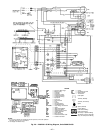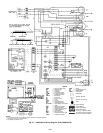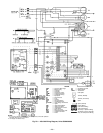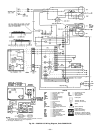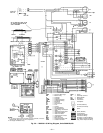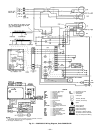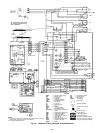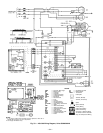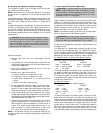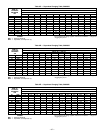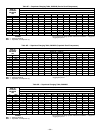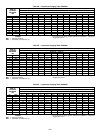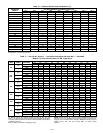
B. Checking and Adjusting Refrigerant Charge
The refrigerant system is fully charged with R-22 refriger-
ant, tested, and factory-sealed.
NOTE: Adjustment of the refrigerant charge is not required
unless the unit is suspected of not having the proper R-22
charge.
A superheat charging label is attached to the inside of the
compressor access door. The label includes a ‘‘Superheat Charg-
ing Table’’ and a ‘‘Required Suction-Tube (F) Temperature’’
chart.
An accurate superheat, thermocouple-, or thermistor-type ther-
mometer, a sling psychrometer, and a gage manifold are re-
quired when using the superheat charging method for evalu-
ating the unit charge. Do not use mercury or small dial-type
thermometers because they are not adequate for this type of
measurement.
CAUTION:
When evaluating the refrigerant charge,
an indicated adjustment to the specified factory charge
must always be very minimal. If a substantial adjust-
ment is indicated, an abnormal condition exists some-
where in the cooling system, such as insufficient airflow
across either coil or both coils.
Proceed as follows:
1. Remove caps from low- and high-pressure service
fittings.
2. Using hoses with valve core depressors, attach low- and
high-pressure gage hoses to low- and high-pressure serv-
ice fittings, respectively.
3. Start unit in Cooling mode and let unit run until sys-
tem pressures stabilize.
4. Measure and record the following:
a. Outdoor ambient-air temperature (F db).
b. Evaporator inlet-air temperature (F wb).
c. Suction-tube temperature (F) at low-side service
fitting.
d. Suction (low-side) pressure (psig).
5. Using ‘‘Superheat Charging Table,’’ compare outdoor-
air temperature (F db) with evaporator inlet-air tem-
perature (F wb) to determine desired system operating
superheat temperature. See Tables 8A-8H and 9A-9F.
6. Using ‘‘Required Suction-Tube Temperature (F)’’ table,
compare desired superheat temperature withsuction (low-
side) operating pressure(psig) to determine proper suction-
tube temperature. See Table 10.
7. Compare actual suction-tube temperature with proper
suction-tube temperature. Using a tolerance of ± 3° F,
add refrigerant if actual temperature is more than 3° F
higher than proper suction-tube temperature, or re-
move refrigerant if actual temperature is more than
3° F lower than required suction-tube temperature.
NOTE: If the problem causing the inaccurate readings is a
refrigerant leak, refer to Check for Refrigerant Leaks section
on page 23.
C. Indoor Airflow and Airflow Adjustments
CAUTION:
For cooling operation, the recommended
airflow is 350 to 450 cfm for each 12,000 Btuh of rated
cooling capacity. Forheating operation, the airflow must
produce a temperature rise that falls within the range
stamped on the unit rating plate.
Table 6 shows the temperature rise at various airflow rates.
Tables 11-14 show both heating and cooling airflows at vari-
ous external static pressures. See Tables 15 and 16 for ICM
(Integrated Control Motor) units air delivery. Refer to these
tables to determine the airflow for the system being in-
stalled. See Table 17 for wet coil pressure drop.
NOTE: Be sure that all supply- and return-air grilles areopen,
free from obstructions, and adjusted properly.
WARNING:
Shut off gas supply then disconnect elec-
trical power to the unit before changing blower speed.
Electrical shock can cause personal injury or death.
Airflow can be changed by changing the lead connections of
the blower motor.
Unit 588A two- or 3-speed motors (except size 030) are fac-
tory wired for low speed operation. Unit 588A030 is factory
wired for medium speed. Units 589A024,036, and 048 (460 v)
two- or 3-speed motors are factory wired for low speed; units
589A030 and 042 are factory wired for medium speed.
For 208/230-v and A.O. Smith 460-v Blower Motors
The motor leads are color-coded as follows:
3-SPEED 2-SPEED
black = high speed black = high speed
blue = medium speed red = low speed
red = low speed
To change the speed of the blower motor, remove the fan mo-
tor speed leg lead from the blower relay (BR). This wire is
attached to terminal BM for single-phase and 3-phase units.
To change the speed, remove and replace with lead for de-
sired blower motor speed. Insulate the removed lead to avoid
contact with chassis parts.
For 460-v GE Motors
The motor leads are color coded as follows:
3-SPEED 2-SPEED
black = high black = high
blue = jumper blue = jumper
orange = medium red = low
red = low
To change the speed of the blower motor, remove fan motor
speed lead from the blower relay (BR) and replace with the
lead for the desired blower motor speed. The motor speed lead
is attached to terminal BM. Insulate removed lead end to avoid
contact with chassis parts. On 3-speed motors only, connect
orange lead to terminal BM of BR. To select high speed on
460-v GE motors, separate the black (female QC) from the
blue lead (male QC) and connect the black lead to the BR.
Insulate the blue lead to avoid contact with any chassis parts.
—35—



